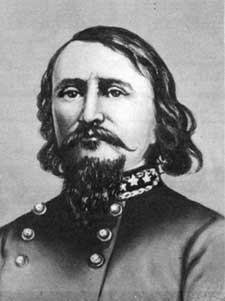|
GETTYSBURG National Military Park |
 |
 Maj. Gen. J. E. B. Stuart, Courtesy National Archives. |
 Maj. Gen. George E. Pickett, Courtesy National Archives. |
The Third Day (continued)
CLIMAX AT GETTYSBURG. Billows of smoke lay ahead of the Union men at the stone wall, momentarily obscuring the enemy. But trained observers on Little Round Top, far to the south, could see in the rear of this curtain of smoke the waves of Confederates starting forward. Pickett finding his brigades drifting southeastward, ordered them to bear to the left, and the men turned toward the copse of trees. Kemper was now approaching on the south of the Codori buildings; Garnett and Armistead were on the north. Halted momentarily at the Emmitsburg Road to remove fence rails, Pickett's troops, with Pettigrew on the left, renewed the advance. Pickett had anticipated frontal fire of artillery and infantry from the strong Union positions at the stone walls on the ridge, but now an unforeseen attack developed. Union guns as far south as Little Round Top, along with batteries on Cemetery Hill, relieved from Confederate fire at the Seminary buildings, opened on the right and left flanks. As Pickett's men drove toward the Union works at The Angle, Stannard's Vermont troops, executing a right turn movement from their position south of the copse, fired into the flank of the charging Confederates. The advancing lines crumbled, re-formed, and again pressed ahead under terrific fire from the Union batteries.
But valor was not enough. As the attackers neared the stone wall they lost cohesion in the fury that engulfed them. All along the wall the Union infantry opened with volley after volley into the depleted ranks of Garnett and Fry. Armistead closed in, and with Lane and Lowrance joining him, made a last concerted drive. At this close range, double canister and concentrated infantry fire cut wide gaps in the attacking front. Garnett was mortally wounded; Kemper was down, his lines falling away on the right and left. Armistead reached the low stone fence. In a final surge, he crossed the wall with 150 men and, with his cap on his sword, shouted "Follow me!" At the peak of the charge, he fell mortally wounded. From the ridge, Union troops rushed forward and Hall's Michigan regiments let loose a blast of musketry. The gray column was surrounded. The ride of the Confederacy had "swept to its crest, paused, and receded."
Two of the divisions in the charge were reduced to mere fragments. In front of the Union line, 20 fallen battle flags lay in a space of 100 yards square. Singly and in little clumps, the remnants of the gray columns that had made the magnificent charge of a few minutes earlier now sullenly retreated across the fields toward the Confederate lines. Lee, who had watched anxiously from Spangler's Woods, now rode out to meet his men. "All this has been my fault," he said to General Wilcox who had brought off his command after heavy losses. "It is I that have lost this fight, and you must help me out of it in the best way you can." And again that night, in a moment of contemplation, he remarked to a comrade, "Too bad! too bad! Oh! too bad!"

|

|
|
Last Modified: Mon, Mar 4 2002 10:00:00 pm PDT |


